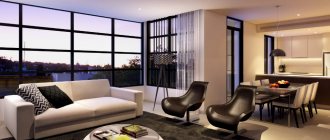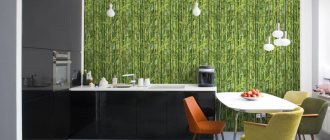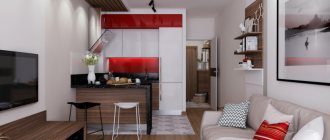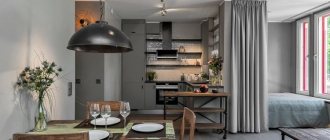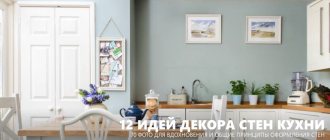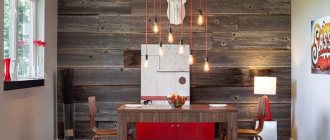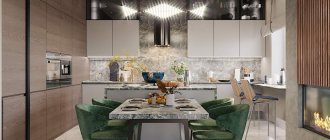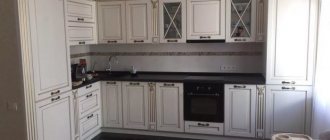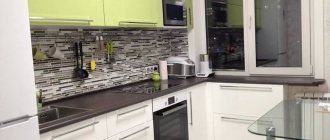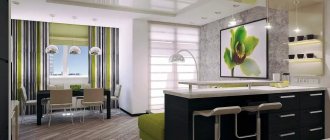Home » Rooms » Kitchen and dining room
Kitchen and dining roomWall decoration
Alyona
16101 Views
MDF panels for the kitchen are the most common way to finish this room. They have all the necessary characteristics that make this material suitable for this room.
What are MDF panels
Using MDF you can transform your kitchen
MDF panels are medium-density boards made from small sawdust, usually obtained from the bark of logs. The bark is crushed into chips, which are then ground into shavings that resemble felt in texture. The sawdust mass is combined with a special binder, lignin.
The hardening process occurs at high pressure and temperatures above 2000 ºС. Thanks to the very small size of sawdust, the slabs are even and smooth, and their appearance resembles natural wood.
The final touch is to sand the panels, making them smooth and uniform. After this, they can be painted, veneered or laminated.
Variety of MDF boards
Advantages and disadvantages of MDF as a finishing material
It is not without reason that MDF boards have gained popularity in the building materials market. They have many advantages compared to others:
- Versatility. MDF finishing is widely used in the interior of walls, ceilings, and in furniture production.
- Aesthetics. MDF panels come in glossy, matte, film-coated, or veneered. Manufacturers can paint them in any color or apply any pattern at the request of the customer.
- High strength. Due to its dense structure, this material is not afraid of impacts. The fasteners connecting the MDF boards do not become loose over time.
- Moisture resistance. MDF is not afraid of moisture and does not swell. You can wet clean the kitchen without fear of ruining the finish.
- Easy to install. The panels are lightweight, so even one person can install them.
- Lifetime. If properly cared for, MDF panels will last longer than their chipboard and even wood counterparts.
- Heat and sound insulation. A room lined with MDF boards becomes noticeably warmer and quieter. Often an additional layer of insulation is installed under the frame of the sheathing to which the panels are attached.
- Plastic. Unlike many other building materials, MDF bends relatively easily. You can use non-standard design solutions in the kitchen interior - semicircular or convex elements on the walls.
- Cheapness. MDF is a relatively inexpensive material; people of any income can afford it.
- Ease of processing. When cutting or drilling, no chips or cracks are formed, the edges and holes are smooth.
Production of MDF panels
MDF has its disadvantages:
- Poor scratch resistance. Despite its density and strength, the surface of the panels is not damaged by sharp objects.
- Unfinished ends. They easily absorb moisture, so they should be carefully processed and condensation should not be allowed to accumulate at the joints.
- Flammability. Care should be taken when installing MDF panels, for example, near a stove or where they are exposed to high temperatures. The surface may become deformed over time.
What other materials can be used?
This concludes the basic ideas about how to decorate an apron. Below are just a few very original options.
Chalkboard paint
A very original method is to make a slate slab instead of an apron. Simply cover the required area three times with chalkboard paint. It is easy to care for: avoid abrasive detergents and rough sponges.
Using a drawing on a board, you can change the look of your kitchen every day, and you definitely won’t get tired of it. It will look especially impressive in a white kitchen.
Brick
Natural brick or gesso are simply not suitable for backsplashes due to the porosity of the material: liquids and dirt will stick to the surface like a sponge and will be difficult to wash off.
Glass comes to the rescue again and protects this interesting design solution. The texture of the brick will be lost, so it is best to move the element away from the cooking area.
Oilcloth
Yes, you can make an apron out of oil fabric. This is one of the cheapest options you can make yourself. All you need to do is take the necessary measurements, select the oilcloth itself, and then attach it to the wall using a furniture stapler.
This option will save the walls from dirt and water, but for a gas stove it is better to choose another option - the oiler can also become charred.
Choosing the best apron for a given situation is not easy. Most often, people are guided only by aesthetics, but do not forget about other considerations:
- Budget;
- Planned period of use;
- Kitchen style;
- Difficulty of reconstruction and replacement;
- cleaning.
Focus on these factors and you'll enjoy your apron for years to come.
Acrylic
Roughly speaking, acrylic is a plastic that can imitate marble or oak. It is cheaper than stone, but is still an expensive option. Acrylic panels are connected virtually seamlessly, so hygiene is not an issue. Acrylic itself is a good material: it does not fade, does not fade, does not leave stains and is durable. Like glass, it gives enormous scope for imagination. But since it is based on polymers, it has certain limitations:
- it can melt next to the stove because it is afraid of high temperatures;
- does not like aggressive and abrasive detergents.
Acrylic looks great in the kitchen, for example, on facades, but is not the best choice for a backsplash.
Laminate or parquet
Laminate is preferred for use on backsplashes and is often cheaper than parquet. It is worth choosing high-class material (32-33) and good locks with moisture protection. You will have to install it yourself, since ready-made laminated panels for the apron are not sold. Installed using liquid nails.
A parquet apron is made differently: first, the “planks” are attached to the substrate with glue or liquid nails, then everything is varnished and also attached to the wall. But the varnish can melt or crack on the deck, so this method isn't for everyone. You can also cover the parquet with glass, but then the apron will be too thick - this is not suitable for everyone. But it looks very original.
Wallpaper
We are not talking about standard options, which are not very suitable for a kitchen apron, but about fiberglass wallpaper. It is durable and strong, and is resistant to extreme temperatures and moisture. There are many different textures available, but a uniform finish with no obvious unevenness is most suitable.
Gluing is no different from the usual process - level and prime the wall, then carefully adjust the fragments and level the surface. Let dry for a while and then coat with washable, waterproof paint. Then you can change the color at least twice a year, which is very convenient, because if you change the furniture, you won’t have to redo the apron.
Wine corks
Yes, that's right - they line the apron with wine corks. They not only collect them themselves, but also buy them (!) in bars and restaurants. To speed up the process, they are cut in half - this makes it easier to glue them to the ground.
The installation method is the same as for parquet flooring. Only corks are porous, so cleaning them will be a big problem. You can resort to an invariable assistant - glass, but is it worth adding it to an already thick apron? Wine stoppers are a good idea for the dining room, but not for the kitchen countertop.
Pebbles
If you love rocky beaches, you can create one in your kitchen. For example, an apron. But since the surface of the stone is not uniform, and it will be very difficult to clean it, dust will get between the stones, and as a result, such a panel will quickly lose its original appearance.
How to choose wall panels for the kitchen
The use of wall panels in kitchen decoration
When choosing panels, the overall style of the house, the size of the kitchen, and lighting are taken into account. In small rooms it is better to use light-colored materials to visually increase the area. One or two elements in a contrasting color will highlight the stylish design.
The set plays an important role; if you choose colors that do not combine with each other, dissonance will arise.
MDF wall panels used for the kitchen will not only provide protection from dirt, but will add a unique style to the interior of the room.
Large kitchens leave room for imagination. Colorful panels or those made in dark colors would be appropriate. Fans of complex designs will love all sorts of patterns or even voluminous photo printing.
So to take it or not to take it?
This issue is quite controversial, since there is a risk, and each person has different motivation. Perhaps the only thing that can be advised is to build on your own financial capabilities for kitchen renovations. The main thing is not to try to save money, but simply evaluate whether there is an opportunity to purchase something else.
Before choosing MDF, you should weigh the pros and cons
In fact, such a particle board seems to be a solution only for poor owners, or as a short-term solution. You can even try to use such an apron for quite a long time, but it is very important to install it correctly, and compliance with safety precautions will now become mandatory for the owner. If you agree to adhere to these conditions and take the risks described, then it’s time to buy particle boards. If not, it’s better to save up a little more and decorate the work area with another material.
What are the options for covering a kitchen with MDF boards?
Standard MDF panels for the kitchen are divided into 3 types:
- Rack and pinion. In the form of slats of different sizes, which are fastened together with grooves. They are mounted on the wall horizontally or vertically, depending on the desired design. They are often used to decorate the area around the dining table using matte panels. This gives the dining area a warm and cozy feeling.
- Sheets. They are usually used to decorate the area between the kitchen unit and the countertop. Laminated options are often used; they are stronger and easier to maintain.
- Panels in the form of tiles. They come in square or rectangular shapes. Suitable for finishing walls or ceilings, they look quite impressive, especially if decorated to look like wood.
In a room with a low ceiling, vertical laying of slatted slabs will look beneficial; it will help elongate the room in height. If the kitchen is cramped, then you should use different textures, for example, lay out the ceiling with rectangular light tiles, one wall with horizontal slats of a dark shade, and lay out the floor with figured ceramic tiles.
Peculiarities
We are not talking about a housewife's overalls in the kitchen, even if the purpose is almost the same.
An apron is a covering over the work area that protects walls and furniture from steam, high temperatures, drops of grease and food. To adequately cope with this task, for its construction it is necessary to choose a material with good characteristics that does not deform over time and can also be maintained. Although some designers choose to use trim throughout the entire wall, more often the backsplash stands out from the overall composition and serves as a striking detail using color, texture or pattern. You can buy the same finish as the countertop to harmonize the space.
Dark surfaces are considered less practical. But if the backsplash is a rich color, the rest of the room should be "muted." Horizontal stripes will help visually stretch the room, and mirror finish will add volume. Colorists recommend using warm shades, as food looks more appetizing against the background.
But these recommendations are very conditional; you need to go beyond your design skills and tastes, since the range of materials is quite wide.
Panel color
There are several options for adding color to MDF boards:
- coloring;
- pasting with film;
- veneering
Painting the panels improves their moisture resistance and wear resistance. You can choose almost any color; manufacturers offer a wide range of shades. The color is fixed with a layer of varnish.
To create an additional effect, you can choose metallic, shanzhan, or pearlescent colors.
Most often, buyers choose panels of calm colors: black, white, gray, brown, wenge, cherry, oak.
Panels covered with film are usually installed as an apron. A glossy apron looks very elegant and refreshes the interior, and it is also easy to maintain. Just wipe it with a damp cloth and it will shine like new.
Veneered boards are popular due to their noble wood-like appearance. The most popular veneers are oak, beech, ash, and pine, but there are rare options, for example, Karelian birch.
Varieties
The following types of MDF boards can be distinguished according to the surface treatment method:
- veneered - a thin veneer of natural wood is glued to the surface;
- laminated - the panel is covered with melamine paper, matte or glossy PVC film;
- laminated - the top layer is made of plastic;
- painted - enamel or moisture-resistant paint is used.
All MDF can be modified by milling to give a more pronounced relief. Laminated panels are most often chosen to decorate the apron. They are the most resistant to light, water and chemicals.
The film can imitate the texture of wood or stone. MDF boards with plastic coating are also popular - they are practical and similar in their properties to plastic panels, but are stronger and more wear-resistant.
Veneered MDF is more expensive and more demanding in terms of operating conditions. The veneer used is oak, beech, walnut, maple, rosewood, wenge and other types of wood. The finished material is not inferior to solid wood in appearance, while having less weight and greater resistance to warping, drying out and humidity. Painted MDF has the lowest price, but also the least practicality, since it does not withstand mechanical and temperature stress.
How to choose design and decor
Design of a kitchen apron made of MDF panels
In every apartment, the kitchen is perhaps the most visited place. In it, the family traditionally meets at the table. That is why it is necessary to carefully select ideas for its design.
The variety of MDF panels provides an excellent opportunity to create a unique interior that will delight its owners. Options are presented that imitate wood, plaster, and stone. There were even panels with a 3D image effect.
You can choose from a variety of patterns that are applied to the surface of the panels. Translucent lace, frost, patina, embossing - this is not a complete list of options. A special case of creating a pattern is a personalized photo or image, for example, a child’s drawing or a memorable photo.
Kitchen design with MDF panels
When choosing a design, it all depends on personal preferences. There are many ideas for decorating walls and ceilings on the Internet and construction magazines.
Basic tips for decorating a room:
- do not mix more than three different shades and two textures in one interior;
- use a glossy plate for the apron;
- decorate the walls below with dark panels approximately 70 cm high, then use light panels;
- The ceiling should be laid out with tiles that are not too small, so as not to create the impression of sloppiness.
Decorative stone tiles will serve as an interesting addition to the decoration. With their help, it is easy to design in a warm Florentine or strict Scandinavian style.
How to make cladding yourself
Installation of these slabs is simple if you follow the basic installation steps. There are two installation options to consider:
- glue installation;
- installation on the lathing.
Glue installation
Cladding with adhesive is chosen for small and medium-sized panels. The walls must be even and smooth.
First you need to cut the MDF board to the required size. Next, the surface is cleaned, degreased and primed.
The metal profile should be secured from below with self-tapping screws to install the first row of slabs.
Next, glue is applied, not to the entire surface, but in strips.
Then repeat the procedure. Excess glue is removed immediately. The most common adhesive composition is “liquid nails”. After completing the cladding, the fittings are attached.
Lathing
Features of installing slabs on sheathing
More often the walls are not perfectly smooth, then a lath or frame is used. In this case, the surfaces are first treated with a primer; it is better to choose one with an antifungal effect. The wooden elements of the sheathing are also primed and impregnated with a heat-resistant compound.
The frame slats are attached at a distance of about 0.5 m from each other; the lower and upper ones should not be tightly adjacent to the floor and ceiling. They are secured with self-tapping screws and leveled. The panels are fastened from the corner using “confirmations”.
Small holes are made in the panels into which plastic cups are inserted. Next, the panels are attached to them and the holes are sealed. If the panels are slatted, they can be secured using a locking system.
The final stage is the installation of skirting boards, decorative slats and corners.
MDF panels are a universal material for interior decoration, ideal for the kitchen. The variety of colors and textures will satisfy the most demanding tastes, and the ease of installation makes up for minor shortcomings. You can update the interior as often as you want, because MDF is quite a budget material.

